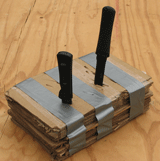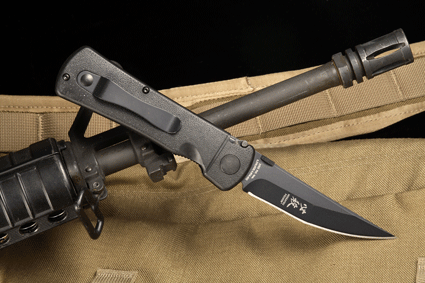No doubt our readers took notice of the Hissatsu, a James Williams-designed, unique fixed-blade knife introduced by CRKT (Columbia River Knife & Tool) a while ago. “Hissatsu” translates as “final blow,” “coup de grâce,” or “kill with one blow,” and the knife so named is a single-purpose, highly specialized knife. It’s not a utility knife, a defensive knife or a hunting knife. Its single offensive purpose has almost no stateside application, but it is an invaluable tool to certain men now fighting this generation’s war against tyranny and evil overseas. Think of it this way: green tip .223 underperformance + close quarters + fast-moving combat units + fanatical enemies = a need for a knife of this sort. In fact, knives are getting more of a workout in the GWOT battlefields than we hear much about just now, and the Hissatsu is a contributor to that trend. Once these experiences can be gathered and documented, we will have a much better body of knowledge about this aspect of warfare than the mostly anecdotal one that exists now.
While the original Hissatsu has been well received by those people for whom it was designed, as a fixed-blade knife with a 7-inch blade, it isn’t the most concealable tool for plainclothes missions or for blending with native populations. For these even more select undertakings, a folding knife is usually the more appropriate weapon. As a result, CRKT introduced the Hissatsu Folder last year. With a 4-inch blade, the natural question is: Is this long enough? Four inches is less desirable than 7 inches or even more, to be sure, but according to designer James Williams, it’s the right compromise for this sort of knife. He points out that a longer than 4-inch blade requires a body (handle) that starts to get difficult to conceal. In other words, the Hissatsu folder has less functionality than its fixed-blade parent, but it’s still got a functional set of tasks that it can perform.
 A Samurai Design
A Samurai Design
The heart of the Hissatsu’s design is the unique blade shape. The unusual osoraku design is one made famous by the legendary Samurai warlord Takeda Shingen. Williams designed his modern osoraku tanto to retain the original’s extraordinary penetrating power and superior slashing potential. “A knife can really only do three things,” says Williams, “It can penetrate, it can cut, and it can chop. The Hissatsu is designed first to penetrate and, secondarily, to slash.” This is in line with its offensive purpose. The Hissatsu isn’t a last-ditch weapon, carried as a desperate final measure, but rather the precisely right weapon for a specific set of circumstances. The 3-7/8-inch osoraku blade of both CRKT Hissatsus is distinguished by the two flat-ground primary grinds that each make up about one half of the blade length. The spine has the very slightest upsweep; so slight that you have to place it on a flat plane to see if it’s really there. The blade is thin (widthwise), and a little on the thick side at 3/20-inch thickness-wise.
Advertisement — Continue Reading Below
Deep Concealment
The Hissatsu folder’s handle is an even 5 inches long, which really is the maximum practical length for true deep concealment. It’s a plain, semi-coffin shape with a small choil at the cutout next to the thumb-opening wafer. This makes for a flat handle, which aids in the critical task of blade orientation, and allows you to simply fold your fingers into a fist in order to smoothly bring the knife into a blade-up (you read that right: blade up) grip as you open it. For a knife that’s primarily meant to penetrate, why a blade-up orientation? For the same reason that cats, bears, and raptors all have claws that move towards their owner as they inflict damage. With a knife, such a grip gives you tremendous ripping power—remember this knife’s mission.
The handle is constructed with CRKT’s InterFrame construction, with 0.059-inch 420J2 liners and pebble-textured black Zytel scales. Construction is open-back with two Torx fasteners. The reversible clip is not affixed with the usual three screws, but with a through-bolt, which is more secure and which makes left/right carry changes easier. The heart of the handle, though, is the massive pivot bolt. In fact, the first thing you notice upon opening the Hissatsu folder is its lateral strength, which is mostly the result of the big bolt. The secure liner lock-up and the AutoLAWKS safety only add to the perception of a small fixed-blade knife. Since tissue is so soft, why is this important? Well, because there are hard things inside, too! And since no one’s standing still—you or the bad guy—you can easily wind up with considerable lateral stress on the knife during use.
The blade is made of AUS 8, hardened to 58-59 HRC. This is a good steel, with good edge-holding and cutting properties. But it is probably overkill (no pun intended) for the Hissatsu folder’s purpose. Put another way: Evaluating the edge-holding characteristics of this knife, or the number of times it can cut manila rope, or subjecting it to some other utility knife test, is irrelevant. As James Williams says, “If you dull this knife when using it for its intended purpose, you are using the wrong tool. The edge is not designed for shaving arm hair.” In fact, part of Mr. Williams’ intent when designing this knife was to keep the cost reasonable. A “better” steel would not add to its function, but would raise its cost.
Advertisement — Continue Reading Below
 Springing Into Action
Springing Into Action
The Hissatsu folder comes with CRKT’s OutBurst assisted-opening mechanism, consisting essentially of a leaf spring under the spine. This spring takes over when the knife is opened to about 30 degrees. The OutBurst spring can be removed by removing a single set screw, and a non-assisted version is also available.
There are three things that someone not familiar with this knife’s special-purpose application may question. The first is the textured but still somewhat slick Zytel scales. The answer here is that even pistols with skateboard tape on them become slippery when coated with blood, and proper technique is the right way to overcome the problem. The second is the lack of a guard or a deeper choil, given this knife’s penetration purpose. The answer to this is, again, that proper technique for the Hissatsu’s application is important to learn. Thirdly, the opening angle of the blade is fairly perpendicular to the handle, and the opening force is greater than usual. Don’t be fooled, these last two characteristics aren’t flaws. Because the knife is carried tip-up for correct and rapid deployment reasons, the extra opening force is a good thing because it also keeps the blade closed. Lastly, the correct opening force angle is easily learned.
So, do you “need” a Hissatsu folder? Chances are very, very good that, no, you don’t “need” one. But you don’t need a 12-inch Bowie either, yet it’s not hard to understand the motivation for owning one. After all, the Bowie knife—whatever that really was—is a part of American history. It was the “fightin’” knife of its day, used as often for offensive purposes as defensive. Like the Hissatsu, the knives we regard as Bowies today—large, usually stylized, clip-point knives—aren’t the most practical utility knives. But they represent a tradition in the building of this nation, albeit perhaps not the most noble of traditions much of the time. The Hissatsu also represents an American tradition: the highly trained, serious, quiet professionalism of today’s top-end special forces, fighting a very serious and very consequential war on our behalf overseas. And this time, it’s a very noble tradition, indeed!
Advertisement — Continue Reading Below























